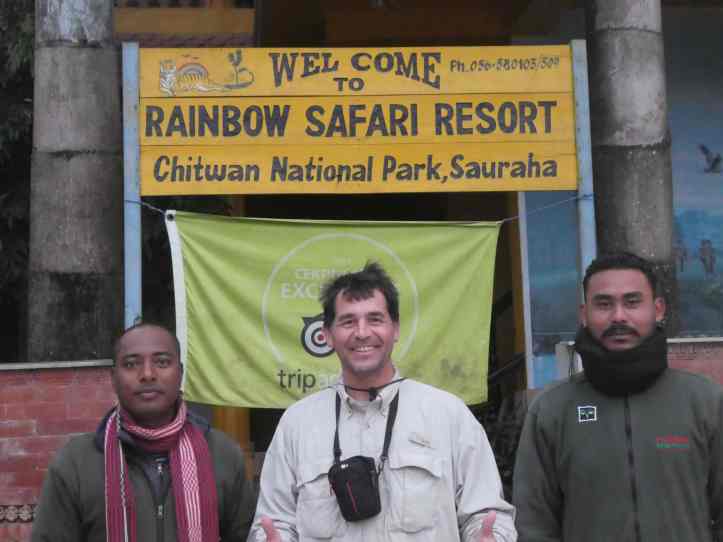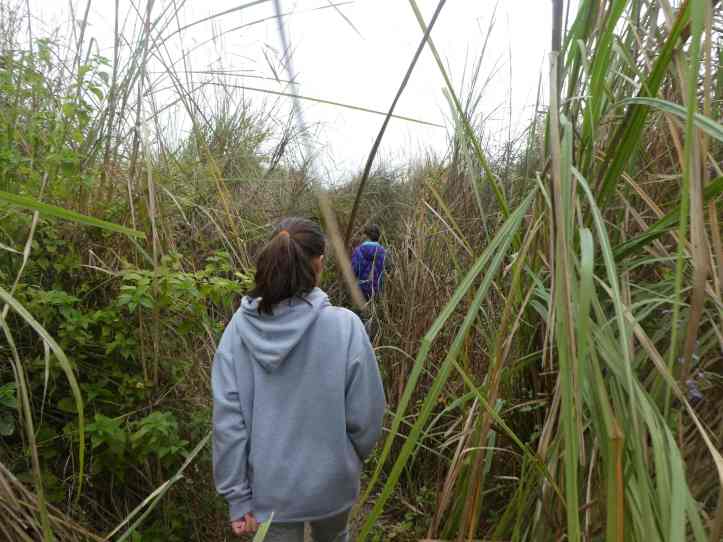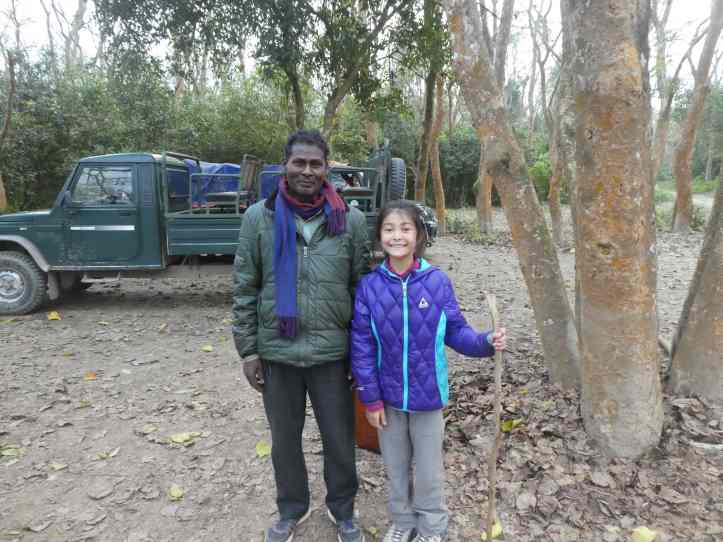Chitwan National Park is a UNESCO world heritage site. Aside from harboring a huge biodiversity, it also it making headway in helping species recover. I wanted to see this park in as many different ways as possible. So we tried to do it all: Walking Safari, Jeep Safari, Cycling Safari, and a Canoe Safari.
Walking Safari

We were all excited to take a walking safari. However in order to hike in an active wildlife we were required by the park service to have two guides: one for the front and one for the back. Each carried a stick.

Our walk started off through the forest along a rhino trail. It was hard to be quiet. Being winter, leaves from the trees littered the ground and we all made crackling sounds as we walked. Passing by piles of rhino dung along the way: “Rhinos use the same toilet to mark territory, this is how poachers know where to find therm.” Quite frequently the dung piles were nearly a meter and covered 3 square meters. More nerve racking than that was encountering fresh poop. As we walked the guides pointed out rhino grazing areas and plants that the rhinos loved to eat. Movement and sounds surrounded us. Sometimes it was chital dear while various birds flitted between perches. All of it caught our eyes and made it hard to focus on larger thing that may be lurking in the woods to get us.

Soon the forest gave way to grassland, and the rhino path gave way to a more defined walk way. “Grass is tall now so it is difficult to see wildlife, if you come back later it’s burnt, you will see more animals” Jai told us. This mean to me, that wildlife was all around lurking in the grass just beyond sight.

Periodically the guides stopped suddenly. Rustling in the grass and snorts meant some animal was near. We froze, they crept forward listening and looking, trying to find a better angle. This happened several times. Sometimes they would conclude it was a boar because of rooting sounds. Other times they concluded it was a bear because of digging sounds. Or, if the sound of fast and fleeting, the concluded it was deer. There were many giant holes in the earth with scratch marks. “These are holes dug by sloth bears looking for termites,” our guides explained. We passed by so much different scat, both old and fresh, that I knew animals were nearby or had walked through the area.
Then, large munching and heavy breathing. Just beyond a water way we saw the top of a rhino eating. We crept forward and looked at the top of it’s back, and periodically it’s ears. It was special to be so close to one of this magnificent animals.

Forging on, we saw three great hornbills in the tree line. They were forging for food in the treetops. They picked away at dead branches and in the crooks of trees looking for bugs. This huge birds are also threatened according to the IUCN red list.

We stopped for a break at constructed elevated platform. From here it was a great view of the grass land. Several plum headed parakeets fed on the seed of the tall elephant grass. “The mango trees we passed earlier used to be the edge of big village, Ramesh’s village. They were all moved out of the park.” Ramesh was the hotel owner and host. I talked to him and his friend about the village later. “They moved us out about 18 years ago. There were 1800 homes and nearly 10,000 people there. The land was very fertile and grew such wonderful rice. The land we moved to wasn’t suited well for agriculture so many of us found different work. They only gave us 6,500 Nepalese Rupees to move, which barely covered the cost of transporting our belongings.” Forming habitats for wild animals is difficult. By definition, it means relocating humans and prioritizing animal needs over human needs. This rarely sits well with humans who are programmed to prioritize their needs over all.
We continued on our walk. As we moved over mud by a stream, Raj our other guide, pointed out fresh tiger prints in the mud. There was blood on the plants near the trail and some got on his pants. Later on we wove through the grasses to look out over various vistas. I looked down and saw that I had gotten some blood stains on my pants as well.

We stopped at another platform above the Rapti River for a lunch break. Sloth bear poop was on the steps up the platform, indicating sloth bears were in the area. We saw other people who were on a walking safari as well. None had seen a rhino yet, so we felt lucky! We ate our lunch and left. Walking along the riverbank, we caught sight of a Gharial crocodile sunning itself. This ancient species are critically endangered according the IUCN red list. With only 900 left in the wild we were extremely lucky to see one. Seeing one alive and in the wild was spectacular.

Just a bit farther we encountered a boar rooting around for lunch. Surprising strong, we saw on lift a large log to get at the grubs and good eats that were under it.

We arrived at the jeep park and waited there for our jeep safari to start.
Jeep Safari
Ten people fit in the jeeps. We all piled in and headed out. Speeding through the forested area, occasionally the jeeps stopped to point out some deer. We rounded a corner and saw giant male rhino grazing on the side of the road. We stopped to gawk and take pictures. It had some wound marks on it indicating it was in a fight. Jai said: “This is the loser.”

We drove through various habitats: savanna, forest, riparian, and wetland looking for wildlife. There were stories of people seeing a tiger a few days ago, and leopard last week. We were all hoping to see one of the rare and illusive animals, but the likelihood was slim to nil to see one….especially with high grass.
Our jeep stopped at the Gharial breeding center. Several enclosures had Gharil at various states of development. As we learned in the National Conservancy Center with Ram, part of their mandate is increasing, preserving, and fostering genetic diversity. The Gharil’s habit is 2% of what it used to be historically and they are already extinct through many of the polluted rivers in India. The breeding center collects eggs from the wild, hatches them and releases the Gharial in various locations through Nepal trying to repopulate restored habitats while diversifying the genetic make up of isolated populations. Since 1981, it has released over 900 Gharial Crocodiles into six different rivers in Nepal.
Back in our jeep we stopped by another military checkpoint (our third one so far). And just beyond that we encountered a sloth bear! Also listed as threatened by the IUCN Red List, these amazing creatures are larger than panda bear or black bear. They have ivory claws, and are highly aggressive. There are videos online of sloth bears fighting tigers and winning. We stayed in the jeep as we watched the bear dig a hole in side of creek bank. It grunted and moaned as it looked for food. Even though it was aggressive and we were no more than 30 meters away, it was clearly hungry and more interested in food prospects than us.

We stopped for a a few minutes along the roadway in the grasslands. Our driver said that sometimes as the sun goes down, animals cross the roadway. But that didn’t happen on our brief time there.

We arrived back at our starting point walking on clouds. We had seen so many animals and birds….more than expected. It would have been hard to top the day off. Except, while eating dinner, the dogs started barking. Ramesh asked us if we wanted to see another rhino. We ran out, and just right there, no more than 3 feet away was a rhino walking down the street munching on plants along side the road. Dogs nipped at its heel, and it could not be bothered! We followed it as it walked down the main street. People took pictures and scooters swerved around it. It turned and went down a side street. An amazing finish to the day.


How we did it
There are a glut of tour operators in the Chitwan and during January, when we were there, they were way below capacity. There were plenty of options:
- Elephant riding Safari (these don’t actually go in the park but stay in the buffer zone).
- Walking Safari (1/2 day all the way to 7 days trekking)
- Jeep Safari
- Canoe Safari (Short 45 minute or a private longer tour is available)
- Bird watching
- City Tours
- Tharu Village Tours
- 20,000 Lakes tour
- Cycling
We went through our hotel Rainbow Safari Lodge. They organized everything with guides. The entrance fees are standard 2000N PR per person, and the half day jeep safari runs 2500 NPR per person. The standard full day walking safari is $80 per person, although I don’t know how much of our bundled cost went towards the half days safari. Walking safaris require two guides. Paying for the park fee also allows for one short canoe ride the following day. (Most people canoe ride to the safari location).
Jeep safaris were offered in the AM, PM, or full day. On the shorter rides, there are few jeep roads, so usually the first jeeps see the wildlife. Our guide said that a full day jeep safari allows for the best chances of seeing wildlife as it goes deep into the park.
This is amazing! Awesome images. Curious, in your tagline “I would like to be…” what is a gonyun? Does that go with your logo??
LikeLike
It’s more of an inside joke with the family; however if you feel like it check out google translate with the Chinese characters. Thank you so much for the generous comments about the images. We were really fortunate!
LikeLiked by 1 person
I keep getting “worker”….I think I may pick John’s mind a bit on this. 🙂
LikeLike
That’s it!
LikeLiked by 1 person
[…] like Manda, Martin, and Francis (and Rosemary and Carol), Lao Sun on the Great Wall, or our guide Jai in Chitwan, as well as many of the other people who we met along the way whose jobs depend on travelers for […]
LikeLike